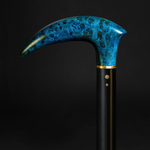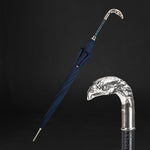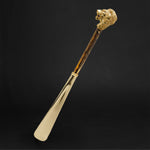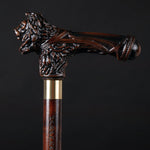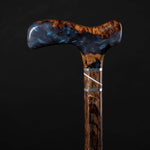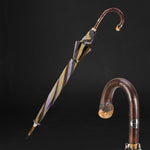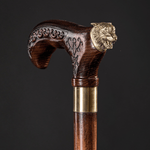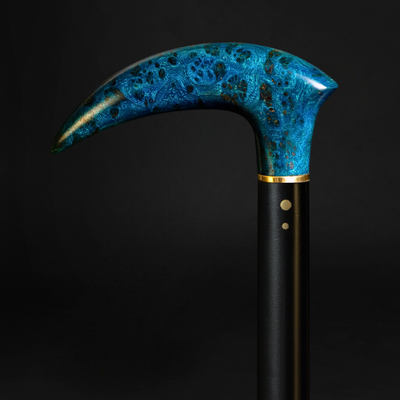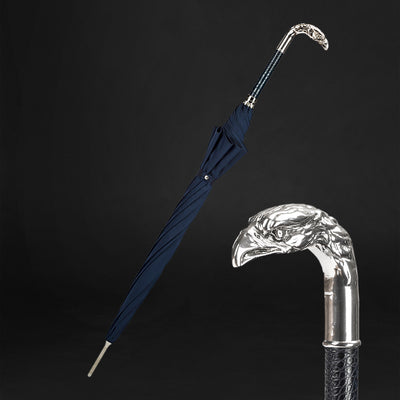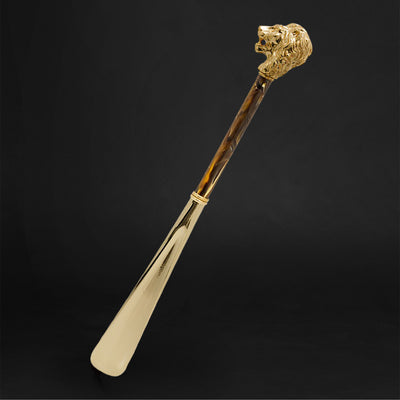You have no items in your shopping cart.
Recent Posts
-
Why an Elegant Cane Is a Thoughtful Gift for Loved Ones?
-
The Art of Christmas Design: Walking Canes That Celebrate the Season in Style
-
How an Ergonomic Walking Cane Handle Prevents Hand and Wrist Strain?
-
How to Walk With a Cane Correctly to Avoid Back or Shoulder Strain?
-
5 Common Mistakes People Make When Buying a Walking Cane (and How to Avoid Them)
-
How to Choose a Walking Cane That Reflects Your Personality (Not Just Your Needs)?
MOST POPULAR NOW
02
Aug
Posture and spinal alignment play a crucial role in our overall health and well-being. The way we hold ourselves affects not only our physical comfort but also our confidence, mood, and even our internal organs' proper functioning. Maintaining correct posture is essential for preventing musculoskeletal issues, reducing the risk of injuries, and promoting optimal body function.
In this article, we will delve into the significance of posture and spinal alignment, exploring how they impact our daily lives and long-term health. Additionally, we will discover how walking sticks can be valuable aids in improving posture, providing the necessary support and stability for a transformative journey towards better musculoskeletal health. Whether young or old, active or recovering, the benefits of walking sticks in posture improvement are accessible to all.
Walking sticks: the path to better posture and spinal alignment
Let us now embark on a journey to understand the importance of posture and spinal alignment and explore how walking sticks can aid us in attaining and maintaining optimal body alignment for a more vibrant and fulfilling life.
Understanding posture and spinal alignment
Posture refers to the position in which we hold our bodies while standing, sitting, or lying down. Good posture involves maintaining a balanced alignment of the body, with the spine in a natural and neutral position. When we have good posture, the muscles, ligaments, and joints work efficiently, allowing the body to function optimally.
The benefits of good posture are numerous and far-reaching. Firstly, it helps reduce strain on the muscles, ligaments, and joints, preventing discomfort and pain. Proper alignment also supports healthy breathing, as the lungs have enough space to expand fully. Good posture contributes to better digestion and organ function, as the body is in a position that facilitates the optimal functioning of internal organs.
Moreover, good posture enhances confidence and self-esteem. When we stand tall and hold ourselves with poise, we project a more positive and assertive image to others. Additionally, maintaining good posture can improve mood and reduce stress levels, as it encourages an open and relaxed body position.

The role of spinal alignment in overall health
Spinal alignment plays a pivotal role in our overall health and well-being. The spine is the central support structure of the body, comprising a series of vertebrae that protect the spinal cord and facilitate movement. When the spine is correctly aligned, it promotes a healthy curvature, ensuring that the body weight is evenly distributed and reducing pressure on individual spinal discs.
Proper spinal alignment is essential for the nervous system's efficient functioning, as it ensures smooth communication between the brain and the rest of the body. Moreover, it helps maintain the body's center of gravity, preventing undue stress on various muscles and joints.
When the spine is misaligned, whether due to poor posture or other factors, it can lead to various health issues. Chronic poor posture can strain muscles and ligaments, leading to discomfort, stiffness, and pain. In severe cases, spinal misalignment can even compress nerves, causing radiating pain and affecting organ function.
Ensuring proper spinal alignment is vital for preventing long-term musculoskeletal issues and promoting overall health. By understanding the significance of posture and spinal alignment, we can take proactive steps towards maintaining a healthy and well-balanced body.
Now that we have grasped the importance of posture and spinal alignment, let us explore how walking sticks can assist us on this journey towards improved musculoskeletal health and vitality.
The science behind walking sticks and posture improvement
Walking sticks, also known as walking canes or hiking poles, have been used for centuries as aids for stability and support during walking and hiking. The science behind how walking sticks promote proper body mechanics lies in their ability to redistribute body weight and improve balance, leading to improved posture and reduced strain on the musculoskeletal system.
-
Redistribution of body weight: When using a walking stick, the force exerted on the lower limbs is distributed between the legs and the stick. This redistribution of body weight reduces the load on the knees, ankles, and hips, lessening the impact on these joints during movement. As a result, walking with a stick can alleviate pressure on the joints and reduce discomfort, especially in individuals with conditions such as arthritis or back pain.
-
Improved balance and stability: Walking sticks provide an additional point of contact with the ground, offering increased stability and balance during walking. This extra support allows individuals to maintain an upright posture, preventing them from leaning forward or to the side, which can strain the spine and back muscles. By encouraging an upright posture, walking sticks promote proper body alignment and reduce the risk of falls, especially on uneven or challenging terrains.
-
Engagement of upper body muscles: Using a walking stick requires the engagement of upper body muscles, such as the shoulders, arms, and core. These muscles play a vital role in maintaining stability and supporting the spine while walking. As individuals walk with a stick, the upper body muscles work in synergy with the lower limbs, creating a harmonious movement pattern that supports overall posture improvement.
Research studies on the effects of walking sticks on posture
The benefits of walking sticks on posture improvement have been the subject of numerous research studies. Several studies have investigated the effects of using walking sticks on balance, gait, and posture, particularly in populations with mobility challenges or age-related changes. Some key findings from these studies include:
-
A study published in the Journal of Aging and Physical Activity found that older adults who used walking sticks during outdoor walking activities demonstrated improved balance and stability. The study concluded that walking sticks provided an effective means of reducing the risk of falls and enhancing posture in the elderly population.
-
Another research published in the European Spine Journal evaluated the effects of walking sticks on individuals with chronic low back pain. The study showed that walking with a stick reduced lumbar lordosis, which is an excessive inward curvature of the lower spine associated with poor posture. The findings indicated that walking sticks could positively influence spinal alignment and posture in individuals with back pain.
-
A study conducted by the Journal of Electromyography and Kinesiology investigated the muscle activation patterns while walking with and without walking sticks. The study revealed that using walking sticks increased the activation of upper body muscles, contributing to improved stability and posture during walking.
These research studies provide empirical evidence supporting the benefits of walking sticks in promoting proper body mechanics, balance, and posture improvement. By understanding the scientific basis behind walking sticks' effectiveness, individuals can confidently embrace these aids as valuable tools for maintaining better musculoskeletal health and overall well-being.
Now that we have explored the science behind walking sticks and posture improvement, let us further discover the transformative potential of incorporating walking sticks into our everyday lives.
Choosing the right walking stick for your needs
Walking sticks come in various types and designs, each tailored to suit different needs and preferences. Whether you are seeking a walking stick for stability during outdoor activities or for everyday support, understanding the available options and considering essential factors will ensure that you select the most suitable walking stick for your specific requirements.
Different types of walking sticks available
-
Single-point walking stick: The most common type of walking stick, featuring a single point or tip at the bottom. It provides stability and support during walking and is suitable for a wide range of users.
-
Quad walking cane: Also known as a quad cane, it has a four-pointed base for enhanced stability. Quad walking canes are particularly beneficial for individuals who require additional support due to balance issues or weakness.
-
Hiking poles: Designed for outdoor activities like hiking and trekking, hiking poles typically come in pairs and have sturdy tips with grips that allow for better traction on various terrains.
-
Folding walking stick: A compact and portable option, folding walking sticks can be easily folded and stored in a bag or purse when not in use, making them ideal for travel and convenience.
-
Adjustable walking stick: These walking sticks come with an adjustable height feature, allowing users to customize the stick's length to match their height and comfort.
Factors to consider when selecting a walking stick
-
Height: Ensure that the walking stick's height matches your height when standing upright. A walking stick set at the right height will provide the most effective support and stability.
-
Weight: Consider the weight of the walking stick, especially if you plan to use it for extended periods or during physical activities. Lightweight materials like aluminum or carbon fiber are excellent choices for ease of use.
-
Grip and handle: The grip or handle of the walking stick should feel comfortable and provide a secure hold. Ergonomic handles or cushioned grips may be more comfortable for prolonged use.
-
Base/tips: Pay attention to the base or tips of the walking stick. Rubber tips offer good traction and stability on various surfaces, while spiked tips are more suitable for outdoor use on rugged terrains.
-
Usage: Determine the primary use of the walking stick. If you need it for everyday support during walking or for rehabilitation purposes, a single-point walking stick or quad cane may be suitable. If you enjoy outdoor activities, consider hiking poles for better stability on uneven terrain.
-
Foldability: If you require a walking stick that can be easily transported or stored, consider a folding walking stick that can be folded into a more compact size.
-
Aesthetics: Lastly, consider the aesthetics of the walking stick. Choose a design and color that appeals to you and complements your style.
By carefully considering these factors, you can select the right walking stick that aligns with your needs, lifestyle, and preferences. A well-chosen walking stick will provide the support and stability you require, empowering you to confidently navigate your daily activities and enhance your overall musculoskeletal health.
Proper usage and technique with walking sticks
Incorporating walking sticks into your daily routines can bring a multitude of benefits to your physical well-being. From enhancing stability and balance to reducing the impact on joints, walking sticks offer valuable support while walking or hiking. However, to truly harness their potential, it is crucial to learn the correct way to hold and use a walking stick. In this comprehensive guide, we will explore the tips and techniques for proper usage of walking sticks, empowering you to make the most out of this simple yet effective tool.
1. Choosing the right walking stick
Selecting the right walking stick is paramount to ensuring maximum comfort and usability. Here are some essential factors to consider when choosing your walking stick:
Material
Walking sticks can be crafted from various materials such as wood, aluminum, or carbon fiber. Each material has its unique characteristics, with wood offering a classic and aesthetic appeal, while aluminum and carbon fiber provide lightweight and durable options.
Height
To determine the ideal height of your walking stick, stand naturally with your arms at your sides. The top of the walking stick should align with your wrist crease when your arm is slightly bent at the elbow. This ensures optimal support and reduces strain on your shoulders.
Grip type
The grip of your walking stick can greatly impact your comfort and control. Common grip types include T-grip, Derby grip, and ergonomic grips. Experiment with different grips to find the one that suits your hand shape and provides a secure hold.
2. Proper holding and posture
Mastering the art of holding a walking stick correctly will significantly improve your walking experience and help you maintain a good posture. Follow these steps for proper holding and posture:
Step 1: Hold the walking stick firmly
Grip the walking stick firmly with your dominant hand, wrapping your fingers around the handle. Ensure a comfortable yet secure grip to maintain control throughout your walk.
Step 2: Opposite hand positioning
When using a walking stick, your opposite hand should move in sync with the opposite leg. For example, if your right leg moves forward, your left hand, holding the walking stick, should move forward simultaneously.
Step 3: Maintain an upright posture
As you walk, keep your back straight, and shoulders relaxed. Avoid slouching or leaning heavily on the walking stick. The stick should provide support, not act as a crutch.
3. Techniques for walking with a stick
Now that you have the proper posture and grip, let's explore some essential techniques for walking with a stick:
Step 1: Start slowly
If you are new to using a walking stick, begin with short walks on flat terrain. Gradually increase the distance and difficulty as you become more comfortable with the stick.
Step 2: Ascending slopes
When ascending slopes, shorten your walking stick to gain better leverage. Plant the stick firmly on the ground ahead of you and use it to propel yourself upward.
Step 3: Descending slopes
While descending slopes, lengthen your walking stick to provide additional stability. Plant the stick slightly behind you to help control your descent and reduce pressure on your knees.
Step 4: Cross obstacles with care
When encountering obstacles like rocks or fallen branches, use your walking stick to probe the area ahead of you. This will help you identify potential hazards and ensure a safe path.
4. Integrating walking sticks into daily routines
Incorporating walking sticks into your daily routines can be a game-changer for maintaining an active lifestyle. Here are some creative ways to make the most of your walking stick:
Step 1: Urban walking
Even in an urban environment, walking sticks can provide added support during longer walks or while navigating uneven sidewalks.
Step 2: Hiking adventures
Walking sticks are indispensable companions on hiking adventures, especially on challenging terrains. They offer stability, reduce pressure on your legs, and help you maintain balance.
Step 3: Fitness walking
Make walking sticks part of your fitness routine by engaging in Nordic walking or other stick-based exercises. These activities can enhance cardiovascular fitness while providing a full-body workout.
Step 4: Rehabilitation
Walking sticks can aid in the rehabilitation process after injuries or surgeries. They provide additional support, easing the strain on affected limbs during recovery.
Embracing the proper usage and techniques with walking sticks can revolutionize your walking experience, offering benefits for both your physical health and mental well-being. Remember to choose the right walking stick for your needs, learn the correct holding and posture techniques, and practice various walking techniques to enhance your mobility. By incorporating walking sticks into your daily routines, you can unlock new levels of activity, adventure, and fitness.
Strengthening core muscles through walking sticks
Walking sticks are not only helpful for improving stability and balance, but they also play a significant role in engaging and strengthening core muscles. As we walk with a walking stick, we activate various muscle groups, including those in the core. In this article, we will explore how walking sticks engage core muscles and provide effective exercises to enhance posture and stability.
How walking sticks engage core muscles?
When walking with a stick, our body naturally engages the core muscles to maintain balance and coordination. The core muscles, which include the abdominals, obliques, and lower back muscles, act as stabilizers during the walking process. Here's how walking sticks help engage the core:
1. Balance and stability
As we move forward with a walking stick, the core muscles work to stabilize the spine and pelvis, keeping us upright and balanced. This engagement is especially crucial when walking on uneven terrain or navigating challenging paths.
2. Rotation and twist
Walking sticks encourage a natural arm swing while walking. This motion creates a rotational force that activates the oblique muscles, which play a key role in stabilizing the torso and enabling smooth movement.
3. Weight distribution
When we lean on the walking stick, the core muscles are responsible for distributing the body's weight and providing support. This distributed load eases the strain on the legs and promotes an efficient walking stride.
Exercises to enhance posture and stability
Incorporating specific exercises into your walking routine can further strengthen the core muscles and improve posture and stability. Let's explore some effective exercises:
1. Walking stick plank
- Start by holding the walking stick horizontally in front of you, gripping it with both hands shoulder-width apart.
- Step back until your body is in a plank position, with your arms extended and the walking stick parallel to the ground.
- Engage your core by pulling your belly button towards your spine, and hold the plank position for 30 seconds to 1 minute.
- Repeat the exercise for 3-4 sets, gradually increasing the holding time as your core strength improves.
2. Side twists with walking stick
- Stand with your feet shoulder-width apart and hold the walking stick horizontally across your shoulders, resting it on your upper back.
- Engage your core muscles and twist your upper body to the right, then return to the center.
- Repeat the twist to the left side.
- Perform 2-3 sets of 10-12 repetitions on each side.
3. Walking stick deadlifts
- Stand with your feet hip-width apart and hold the walking stick in front of your body with both hands.
- Hinge at your hips and lower the walking stick towards the ground, keeping your back straight and core engaged.
- Return to the starting position by squeezing your glutes and using your core to lift yourself back up.
- Perform 3 sets of 8-10 repetitions, gradually increasing the intensity as you progress.
Walking sticks are versatile tools that not only provide support during walks but also offer an excellent opportunity to engage and strengthen core muscles. By incorporating walking stick exercises into your routine, you can enhance your posture, stability, and overall walking experience. Remember to maintain proper form during exercises and be consistent in your practice for best results. Strengthening your core through walking sticks will not only benefit your walking abilities but also contribute to better overall fitness and well-being.
Enhancing balance and stability with walking sticks
Walking sticks are not only valuable tools for providing support during walks, but they also have a profound impact on enhancing balance and coordination. These simple yet effective aids can significantly improve stability and help individuals of all ages maintain their equilibrium while navigating various terrains. In this article, we will explore the importance of walking sticks in enhancing balance and coordination, as well as activities that can further improve balance using these remarkable tools.
The impact of walking sticks on balance and coordination
Balance and coordination are fundamental aspects of our daily movements. As we age or face physical challenges, our balance may become compromised, leading to an increased risk of falls and injuries. Walking sticks can play a crucial role in mitigating these risks and improving overall stability. Here's how walking sticks impact balance and coordination:
1. Weight distribution
One of the key benefits of using walking sticks is their ability to distribute body weight more evenly. When walking with a stick, the load is shared between the legs and the stick, reducing pressure on the lower extremities. This balanced weight distribution enhances stability and minimizes the likelihood of stumbling or falling.
2. Support on uneven terrain
Walking sticks provide essential support on uneven terrain, such as hiking trails or rocky paths. By offering an additional point of contact with the ground, walking sticks help individuals maintain their balance even on challenging surfaces.
3. Confidence boost
The presence of a walking stick can instill a sense of confidence in individuals who may feel uncertain about their balance. This increased confidence encourages them to stay active, engage in physical activities, and maintain a more independent lifestyle.
4. Upper body activation
When using a walking stick, the upper body is engaged in the walking process, resulting in improved coordination. The arm movements required to swing the walking stick create a natural rhythm that syncs with the leg movements, enhancing overall coordination.
Activities to improve balance using walking sticks
While simply using a walking stick during walks can significantly improve balance and stability, targeted activities can further enhance these benefits. Let's explore some activities that incorporate walking sticks to improve balance:
1. Balancing exercises
- Stand on one leg and hold the walking stick horizontally across your shoulders for support.
- Maintain your balance for as long as you can, aiming for at least 30 seconds on each leg.
- As you progress, try closing your eyes during the exercise to challenge your balance further.
2. Step-ups
- Find a step or elevated surface and hold the walking stick in both hands.
- Step up onto the surface with one foot, engaging your core and using the walking stick for support.
- Lower yourself back down and repeat the exercise with the other leg.
- Perform 10-12 step-ups on each leg for 2-3 sets.
3. Sideways walks
- Mark a straight line on the ground and hold the walking stick horizontally across your shoulders.
- Walk sideways along the line, keeping your body facing forward and using the walking stick for support.
- Perform several rounds of sideways walks in each direction to challenge your lateral balance.
Walking sticks are invaluable companions for enhancing balance and stability, promoting confidence, and improving coordination. By using these simple yet effective tools during walks and incorporating targeted balance-improving activities, individuals can experience a notable difference in their overall equilibrium and mobility. Whether you are recovering from an injury, facing age-related balance challenges, or simply looking to boost your stability, walking sticks can be a game-changer in supporting your active lifestyle.

Walking sticks for specific conditions and populations
Walking sticks are versatile tools that offer support and stability for individuals of various ages and conditions. They are especially beneficial for elderly individuals and those experiencing back pain. In this article, we will delve into the advantages of using walking sticks for these specific populations, highlighting how these simple aids can make a significant difference in their mobility and overall quality of life.
Walking sticks for elderly individuals
As we age, our bodies undergo changes that can affect balance and stability. Elderly individuals may find it challenging to walk confidently, increasing the risk of falls and injuries. Walking sticks can be a practical solution to address these concerns and provide the necessary support. Here are the benefits of walking sticks for elderly individuals:
1. Increased stability
Walking sticks act as an extra point of contact with the ground, providing enhanced stability during walks. This added support can significantly reduce the likelihood of slips or falls, instilling confidence in elderly individuals as they move around.
2. Reduced strain on joints
With age, joint health may deteriorate, leading to discomfort while walking. Walking sticks help distribute body weight, alleviating pressure on the legs and joints. This reduced strain allows elderly individuals to walk more comfortably and for longer durations.
3. Support on uneven surfaces
Outdoor surfaces, such as uneven sidewalks or gravel paths, can pose challenges for elderly individuals. Walking sticks provide valuable support on such terrains, enabling seniors to maintain their balance and enjoy outdoor activities with greater ease.
4. Independence and freedom
By using walking sticks, elderly individuals can maintain their independence and freedom to move around without constant assistance. They can engage in daily activities and social interactions with the added security provided by the walking stick.
Benefits of walking sticks for those with back pain
Back pain is a common issue that can severely impact mobility and daily activities. Walking sticks can serve as effective aids for individuals experiencing back pain, offering relief and support. Here's how walking sticks benefit those with back pain:
1. Posture support
Using a walking stick encourages individuals to maintain an upright posture while walking. The stick provides support to the spine, reducing the strain on the back muscles and promoting proper alignment.
2. Even weight distribution
Walking sticks help distribute body weight evenly between the upper body and lower extremities. This balanced weight distribution eases the pressure on the back and minimizes discomfort while walking.
3. Core muscle engagement
Walking with a stick engages the core muscles, promoting core strength and stability. Strengthening the core can alleviate back pain and improve overall spinal health.
4. Reduced impact on spine
With the support of a walking stick, individuals can lessen the impact on their spine when walking on hard surfaces. This reduced impact can be particularly beneficial for those with back pain or spinal issues.
Walking sticks are valuable tools that cater to specific conditions and populations, such as elderly individuals and those with back pain. These simple aids offer increased stability, reduced strain on joints, and enhanced mobility for the elderly. For individuals dealing with back pain, walking sticks provide posture support, even weight distribution, and core muscle engagement. By incorporating walking sticks into their daily routines, individuals with specific conditions can enjoy improved mobility, confidence, and a greater sense of independence.
Combining walking sticks with other posture-improving techniques
Walking sticks are not only excellent aids for stability and support during walks but can also be integrated with other posture-improving techniques to enhance overall body alignment and well-being. In this article, we will explore how walking sticks can be combined with practices like yoga or Pilates and how they can complement ergonomic adjustments to promote better posture and a healthier lifestyle.
1. Integrating walking sticks with yoga or pilates
Yoga and Pilates are renowned for their focus on body awareness, flexibility, and core strength. By incorporating walking sticks into these practices, individuals can experience an added dimension of stability and balance during various poses and movements. Here's how to integrate walking sticks with yoga or Pilates:
a. Standing poses
During standing yoga or Pilates poses, such as the Tree Pose or the Warrior Pose, holding a walking stick for support can assist in maintaining balance. The stick provides an anchor point and helps individuals find stability, allowing them to focus on proper alignment and breath control.
b. Balance and flexibility
Yoga and Pilates often involve exercises to improve balance and flexibility. Utilizing walking sticks during these exercises can provide additional stability, encouraging practitioners to explore their range of motion with confidence.
c. Modified stretches
For individuals with limited flexibility or mobility, walking sticks can be used to modify stretches in yoga or Pilates. They extend reach and aid in achieving proper form, making poses more accessible and effective.
d. Core activation
During core-strengthening exercises like Plank or Boat Pose, holding a walking stick horizontally can engage the core muscles further. The stick serves as an additional challenge to maintain stability, enhancing the effectiveness of the workout.
2. Using walking sticks alongside ergonomic adjustments
Beyond enhancing exercise practices, walking sticks can be combined with ergonomic adjustments in everyday activities to promote better posture and reduce strain on the body. Here's how to use walking sticks alongside ergonomic adjustments:
a. Workspace setup
At the office or home workstation, ensure that the chair, desk, and computer monitor are ergonomically aligned. While sitting, keep the walking stick nearby to support proper posture and relieve back tension.
b. Standing desks
For those using standing desks, a walking stick can provide intermittent support to reduce the strain on the legs and back. Alternating between sitting and standing with the aid of the stick can contribute to better posture throughout the workday.
c. Lifting and carrying
When lifting or carrying heavy objects, the walking stick can help distribute the weight, reducing the pressure on the spine and lower back. Remember to use proper lifting techniques in conjunction with the walking stick support.
d. Daily mobility
Incorporate the walking stick into everyday activities such as walking around the house, running errands, or gardening. The stick serves as a reminder to maintain an upright posture and engage the core muscles.
Combining walking sticks with other posture-improving techniques can have a profound impact on overall body alignment, stability, and well-being. Integrating walking sticks with yoga or Pilates enhances the benefits of these practices, while using the sticks alongside ergonomic adjustments promotes better posture in daily activities. By embracing these integrative approaches, individuals can experience improved posture, reduced strain on the body, and enhanced overall health and mobility.
The psychological aspect of posture improvement with walking sticks
Posture improvement with walking sticks extends beyond physical benefits, as it also has a profound psychological impact on individuals. By enhancing posture, especially with the aid of walking sticks, individuals experience boosted confidence and self-esteem, along with a strengthened mind-body connection. In this article, we will explore how improved posture with walking sticks positively influences the psychological aspect, fostering a healthier and more confident outlook on life.
Boosting confidence and self-esteem through improved posture
Good posture plays a pivotal role in how we present ourselves to the world. Walking sticks can be transformative in promoting better posture, leading to increased confidence and self-esteem. Here's how improved posture with walking sticks contributes to these psychological benefits:
1. Heightened sense of security
When individuals walk with a walking stick, they experience enhanced stability and balance. This newfound sense of security allows them to move more confidently and fearlessly, whether it's navigating through crowded spaces or taking on outdoor adventures.
2. Improved body image
Walking with proper posture, supported by a walking stick, creates a more aligned and elongated appearance. This improved body alignment can positively influence how individuals perceive themselves, leading to a more positive body image.
3. Empowerment and independence
Using a walking stick can instill a sense of empowerment and independence in individuals who may have faced mobility challenges. With the support of the walking stick, they regain control over their movements and daily activities, enhancing their self-esteem.
4. Positive reception from others
Confident posture can leave a lasting impression on others, resulting in a more positive reception from friends, family, and peers. Improved posture with the aid of walking sticks can project a sense of poise and self-assurance, contributing to more favorable social interactions.
The mind-body connection in maintaining good posture
The mind-body connection plays a significant role in maintaining good posture with walking sticks. Being mindful of one's body and movements while using the stick can further enhance the physical and psychological benefits. Here's how the mind-body connection contributes to maintaining good posture:
1. Mindful awareness
Walking with a walking stick encourages individuals to be mindful of their body's alignment and movement. Heightened awareness of posture helps individuals make conscious adjustments to maintain optimal body positioning.
2. Relaxation and stress reduction
Being mindful of posture and focusing on maintaining a balanced stance can induce a sense of relaxation. Reduced stress levels contribute to better posture, creating a positive feedback loop between the mind and body.
3. Positive reinforcement
As individuals become more aware of the connection between their thoughts and physical posture, they can provide positive reinforcement to themselves. Acknowledging and celebrating improvements in posture can lead to increased motivation to maintain good posture consistently.
4. Emotional well-being
The mind-body connection impacts emotional well-being. By maintaining good posture, individuals may experience improved mood, reduced anxiety, and a greater sense of overall well-being.
The psychological aspect of posture improvement with walking sticks is a vital component of the benefits it offers. Beyond the physical advantages, using walking sticks to enhance posture boosts confidence and self-esteem, empowering individuals to embrace a more positive body image. The mind-body connection further reinforces good posture, leading to increased mindfulness, relaxation, and emotional well-being. By recognizing and nurturing the psychological impact of improved posture with walking sticks, individuals can achieve a harmonious balance between their physical and mental well-being.
Debunking myths and misconceptions about walking sticks
Walking sticks, often seen as simple aids for stability and support, can be surrounded by various myths and misconceptions. In this article, we aim to address common misconceptions about walking sticks and clarify their benefits without promoting dependency. By understanding the truth behind these myths, individuals can make informed decisions about using walking sticks to enhance their mobility and well-being.
Myth 1: Walking sticks are only for the elderly or injured
One prevalent myth is that walking sticks are solely for the elderly or those with injuries. While walking sticks are indeed beneficial for these populations, they offer advantages to people of all ages and fitness levels. Walking sticks can enhance stability, provide support on uneven terrain, and reduce pressure on joints for individuals engaged in various activities, such as hiking or fitness walking.
Myth 2: Using walking sticks makes you look weak or disabled
Another misconception is that using walking sticks may convey weakness or disability. In reality, walking sticks are tools that promote independence and confidence. They assist individuals in maintaining an upright posture, improve balance, and allow them to engage in activities they might otherwise avoid due to mobility concerns. Embracing walking sticks with a positive attitude emphasizes a proactive approach to health and well-being.
Myth 3: Walking sticks cause dependency
A common myth is that relying on walking sticks can lead to dependency and weakened muscles. However, when used correctly, walking sticks can actually promote muscle engagement and core strength. Walking sticks provide support while encouraging individuals to maintain an active lifestyle, contributing to overall muscle tone and mobility.
Myth 4: Walking sticks are uncomfortable to use
Some people believe that walking sticks are uncomfortable or cumbersome. In reality, walking sticks are designed to be ergonomic and adjustable to suit individual needs. Properly fitted walking sticks should feel comfortable and secure, allowing for a natural and comfortable walking experience.
Myth 5: Walking sticks are not fashionable
There is a misconception that walking sticks are outdated and unfashionable. However, walking sticks are available in various styles and materials, including sleek and modern designs. From traditional wooden sticks to lightweight and stylish options, walking sticks can be both practical and fashionable accessories.
Clarifying the benefits without promoting dependency
While walking sticks offer numerous benefits, it is essential to clarify that their usage should not create dependency. Instead, walking sticks should be viewed as aids that support an active lifestyle and enhance mobility. Here's how to strike the right balance:
1. Gradual integration
Individuals can gradually integrate walking sticks into their daily routines, using them when needed and relying on their support during challenging activities. As confidence and stability increase, individuals may find themselves using the walking stick less frequently.
2. Utilize proper technique
Using walking sticks with proper technique is crucial to avoid over-reliance on the aid. Learning correct posture and gait while using the walking stick ensures that individuals engage their muscles effectively and maintain independence in their movements.
3. Explore other exercises
To prevent overdependence on walking sticks, individuals can explore other exercises and activities that promote balance, strength, and flexibility. Incorporating yoga, Pilates, or other fitness routines can contribute to overall well-being and mobility.
Debunking myths and misconceptions about walking sticks is essential to fully appreciate their benefits as aids for stability and support. These aids are not limited to specific age groups or those with injuries; instead, they can enhance the mobility and confidence of individuals of all ages. By clarifying the advantages of walking sticks without promoting dependency, individuals can embrace these aids as empowering tools that contribute to a more active and fulfilling lifestyle.
The role of walking sticks in rehabilitation and recovery
Walking sticks play a crucial role in post-injury or post-surgery rehabilitation, offering essential support and stability during the recovery process. When used appropriately, walking sticks can significantly aid individuals in regaining mobility and confidence. Collaborating with healthcare professionals ensures proper usage and maximizes the benefits of walking sticks in rehabilitation and recovery.
Supporting post-injury or post-surgery rehabilitation
After an injury or surgery, the body often requires time to heal and rebuild strength. During this rehabilitation phase, walking sticks offer invaluable assistance in the following ways:
1. Weight bearing support
Walking sticks provide support and help distribute body weight more evenly, reducing strain on the injured or recovering limb. This support is particularly beneficial for individuals with lower limb injuries or those who underwent hip or knee surgeries.
2. Enhanced stability
Maintaining balance can be challenging during the recovery process. Walking sticks offer enhanced stability, minimizing the risk of falls and helping individuals move around with greater confidence.
3. Reduced impact on joints
Using a walking stick can help reduce impact on joints like the ankles, knees, and hips, which may be sensitive during the recovery period. By lessening the load on these joints, walking sticks aid in pain management and promote a more comfortable walking experience.
4. Gradual progression
Walking sticks allow for gradual progression in weight-bearing activities during rehabilitation. As the individual's strength and mobility improve, they can gradually rely less on the walking stick, promoting a smooth transition to full recovery.
Collaborating with healthcare professionals for proper use
To ensure the optimal use of walking sticks in rehabilitation and recovery, collaboration with healthcare professionals is essential. Here's how healthcare professionals can assist in the proper use of walking sticks:
1. Evaluation and recommendation
Healthcare professionals, such as physical therapists or orthopedic specialists, evaluate the individual's condition and recommend the appropriate type of walking stick. They consider factors like the type of injury or surgery, the level of weight-bearing allowed, and the individual's overall mobility.
2. Fitting and adjustment
Healthcare professionals ensure that the walking stick is properly fitted and adjusted to the individual's height and comfort. An accurately sized walking stick maximizes support and minimizes the risk of strain or discomfort.
3. Technique training
Proper technique is essential when using a walking stick for rehabilitation. Healthcare professionals provide guidance on how to hold, position, and move with the walking stick to optimize support and stability.
4. Monitoring progress
Throughout the rehabilitation process, healthcare professionals monitor the individual's progress and make necessary adjustments to the walking stick usage. As the individual's condition improves, healthcare professionals may recommend reducing reliance on the walking stick gradually.
Walking sticks play a vital role in rehabilitation and recovery after injuries or surgeries. They provide weight-bearing support, enhanced stability, and reduced joint impact, aiding individuals in regaining mobility and confidence during the recovery process. Collaboration with healthcare professionals ensures proper usage and maximizes the benefits of walking sticks in rehabilitation. With the appropriate guidance and support, individuals can effectively integrate walking sticks into their recovery journey, facilitating a smoother and more successful rehabilitation process.
Incorporating walking sticks into everyday life
Walking sticks, once seen purely as functional aids, are now evolving into fashionable and trendy accessories that enhance mobility while making a style statement. Integrating walking sticks into various lifestyles goes beyond rehabilitation or support during walks, as these versatile tools can be embraced by individuals of all ages and interests. In this article, we will explore how to make walking sticks fashionable and trendy, as well as how to seamlessly integrate them into everyday life.
Making walking sticks fashionable and trendy
Gone are the days when walking sticks were plain and mundane. Today, designers and manufacturers are incorporating creativity and innovation into the designs, making walking sticks fashionable and trendy. Here are some ways to achieve a stylish and chic look with walking sticks:
1. Material selection
Choose walking sticks made from unique materials like lightweight aluminum, sleek carbon fiber, or even stylishly crafted wood. The material selection can add elegance and flair to the walking stick's appearance.
2. Colorful patterns and designs
Opt for walking sticks with colorful patterns, artistic designs, or even custom prints. These eye-catching aesthetics add a touch of personalization to the walking stick, making it a reflection of the individual's personality and style.
3. Designer handles and grips
Explore walking sticks with designer handles and grips, such as those inspired by luxury accessories. From leather-wrapped handles to ergonomic grips, these details elevate the overall look and feel of the walking stick.
4. Adjustable and collapsible features
Consider collapsible walking sticks that can be easily folded and stored when not in use. These space-saving options are not only practical but also sleek and modern in design.
Integrating walking sticks into various lifestyles
Walking sticks can seamlessly integrate into various lifestyles, enhancing daily activities and experiences. Here's how to incorporate walking sticks into different routines and interests:
1. Urban commuters
For urban dwellers, walking sticks can be essential companions during daily commutes. Whether navigating crowded streets or using public transportation, the walking stick provides stability and support.
2. Fitness enthusiasts
Fitness enthusiasts can incorporate walking sticks into their outdoor activities, such as power walking, hiking, or Nordic walking. The added support and upper body engagement enhance the overall workout experience.
3. Nature explorers
Walking sticks are perfect companions for nature enthusiasts exploring hiking trails and natural landscapes. The sticks offer support on uneven terrains, allowing individuals to fully immerse themselves in outdoor adventures.
4. Travelers
Travelers can benefit from collapsible walking sticks that easily fit into suitcases. Whether strolling through airports or exploring new destinations, the walking stick provides comfort and stability during the journey.
5. Social gatherings
Walking sticks can be incorporated into social gatherings and events as stylish accessories. Customized walking sticks can be coordinated with outfits, adding a touch of elegance to special occasions.
Incorporating walking sticks into everyday life goes beyond practicality, as they now offer a fusion of functionality and fashion. By embracing walking sticks with creative designs, trendy materials, and personalized touches, individuals can make a style statement while enhancing mobility. From urban commutes to nature exploration, walking sticks seamlessly integrate into various lifestyles, supporting individuals in their daily activities and enriching their experiences. Whether for fashion-forward individuals or outdoor enthusiasts, walking sticks have become versatile tools that effortlessly adapt to diverse interests and routines.
Promoting posture awareness in communities and institutions
Posture awareness is essential for maintaining good musculoskeletal health and overall well-being. Educating the public about posture-related health issues and encouraging the usage of walking sticks can have a significant positive impact on communities and institutions. In this article, we will explore initiatives to promote posture awareness, raise awareness about posture-related health issues, and encourage the appropriate use of walking sticks for better mobility and stability.
Educating the public about posture-related health issues
Effective education about posture-related health issues is key to fostering a culture of proactive posture awareness in communities and institutions. Here are some initiatives to consider:
1. Public workshops and seminars
Organize public workshops and seminars focused on posture awareness. Invite healthcare professionals, physical therapists, and experts to discuss the importance of good posture, its impact on overall health, and practical tips for maintaining correct body alignment.
2. Educational campaigns
Launch educational campaigns through various media channels, including social media, websites, and local newspapers. These campaigns can share informative content, infographics, and success stories from individuals who have improved their posture.
3. Workplace posture programs
Collaborate with workplaces and institutions to implement posture improvement programs. Provide ergonomic assessments and workshops to help employees understand the importance of good posture and how to maintain it while working.
4. School-based initiatives
Introduce posture education in schools, incorporating it into physical education curriculums and health classes. Teach students about proper posture habits from a young age to instill lifelong practices.
Initiatives to encourage walking stick usage
Promoting the use of walking sticks as aids for better mobility and stability is an important aspect of posture awareness. Here are initiatives to encourage walking stick usage:
1. Community walking groups
Establish community walking groups that use walking sticks during group walks. These groups not only promote physical activity but also create an environment where individuals feel comfortable using walking sticks.
2. Walking stick demonstrations
Conduct walking stick demonstrations in public spaces, parks, or community centers. Allow people to try different types of walking sticks and experience the benefits firsthand.
3. Collaborations with healthcare facilities
Collaborate with healthcare facilities, such as hospitals and rehabilitation centers, to educate patients about the appropriate use of walking sticks during recovery and rehabilitation.
4. Walking stick rental programs
Create walking stick rental programs in parks or tourist destinations where individuals can rent walking sticks for outdoor activities. This initiative allows people to try walking sticks without committing to purchasing them.
Promoting posture awareness in communities and institutions is a proactive approach to improving musculoskeletal health and overall well-being. Educating the public about posture-related health issues through workshops, campaigns, and school-based initiatives helps individuals understand the importance of maintaining correct body alignment. Encouraging the usage of walking sticks through walking groups, demonstrations, collaborations with healthcare facilities, and rental programs fosters a culture where individuals can embrace these aids for better mobility and stability. By integrating these initiatives, we can build healthier and more posture-conscious communities and institutions.
Summary: the journey to better posture with walking sticks
In this comprehensive exploration of the role of walking sticks in posture improvement, we delved into the various benefits and impact they have on individuals' musculoskeletal health and overall well-being. Walking sticks, once considered mere functional aids, have now evolved into fashionable accessories that offer essential support while making a style statement. From promoting confidence and self-esteem to aiding in rehabilitation and recovery, walking sticks have proved to be versatile tools that cater to individuals of all ages and lifestyles.
We first addressed the physical aspect of walking sticks, highlighting their impact on balance, stability, and weight distribution. By providing an additional point of contact with the ground, walking sticks reduce strain on joints, making them especially beneficial for the elderly, those with back pain, and individuals recovering from injuries or surgeries. Moreover, integrating walking sticks with yoga, Pilates, and ergonomic adjustments further enhances their advantages, allowing individuals to embrace better posture and core muscle engagement.
Beyond the physical benefits, we explored the psychological aspect of walking sticks. By boosting confidence and self-esteem, these aids empower individuals to move confidently and independently. The mind-body connection further reinforces the importance of maintaining good posture with walking sticks, as mindfulness and relaxation contribute to overall well-being.
Incorporating walking sticks into everyday life has become seamless, with designers and manufacturers offering stylish options in various materials and designs. Urban commuters, fitness enthusiasts, nature explorers, travelers, and social gatherers can all embrace walking sticks as fashionable companions that support their respective lifestyles.
To promote posture awareness in communities and institutions, we highlighted the significance of educating the public about posture-related health issues. Through workshops, campaigns, workplace programs, and school-based initiatives, individuals can become proactive about maintaining good posture. Encouraging walking stick usage is also crucial, achieved through community walking groups, demonstrations, collaborations with healthcare facilities, and walking stick rental programs.
In conclusion, the journey to better posture with walking sticks is not just about physical support but also a conscious effort to enhance overall well-being. By taking action and incorporating walking sticks into their lives, readers can improve their posture, experience increased stability, and foster a culture of posture awareness. Embracing these aids with confidence, individuals can confidently stride towards better musculoskeletal health and a more vibrant and active lifestyle.
FAQs: answering common questions about walking sticks and posture improvement
1. What are the best materials for walking sticks?
Walking sticks are available in various materials, each with its own advantages. The best material depends on individual preferences and needs. Some popular materials for walking sticks include:
-
Aluminum: Lightweight and durable, aluminum walking sticks are ideal for individuals seeking portability and ease of use.
-
Wood: Traditional wooden walking sticks offer a classic and elegant look. They are sturdy and provide excellent support.
-
Carbon Fiber: Modern and sleek, carbon fiber walking sticks are both lightweight and strong, making them a great choice for active individuals.
-
Adjustable: Many walking sticks are adjustable, allowing users to customize the height according to their comfort and needs.
Ultimately, the best material for a walking stick is one that feels comfortable, suits the user's lifestyle, and provides the necessary support and stability.
2. Can children use walking sticks to improve posture?
Yes, children can use walking sticks to improve posture, especially during outdoor activities and adventures. When used under adult supervision and guidance, walking sticks can offer support and stability for children navigating uneven terrains or hiking trails. Additionally, walking sticks can help children maintain an upright posture and develop good body alignment from an early age. It is essential to ensure that the walking stick's height is suitable for the child's height, and they are taught proper technique and usage.
3. Are walking sticks suitable for individuals with balance issues?
Yes, walking sticks are suitable for individuals with balance issues. In fact, walking sticks can be particularly beneficial for those who experience balance challenges, as they provide an additional point of support while walking. Individuals with balance issues may find walking sticks helpful in reducing the risk of falls and increasing their confidence during movement. However, it is crucial to consult with a healthcare professional or physical therapist to ensure that the walking stick is appropriate for the specific balance issues and to receive proper guidance on using the walking stick safely and effectively.
Remember, walking sticks can be valuable aids for posture improvement and mobility, but it is essential to choose the right material, consider the user's needs, and seek professional guidance when necessary to maximize their benefits.
Conclusion
Embracing improved posture and spinal alignment with the aid of walking sticks can lead to a lasting positive impact on individuals' overall health and well-being. Throughout this exploration of the role of walking sticks in posture improvement, we have discovered their diverse benefits and transformative potential. From providing support and stability during rehabilitation to empowering individuals with confidence and self-esteem, walking sticks have proven to be versatile tools that cater to various age groups, lifestyles, and needs.
The physical benefits of walking sticks, such as enhanced balance, reduced joint impact, and improved weight distribution, contribute to increased comfort and ease of movement. By supporting individuals during post-injury or post-surgery rehabilitation, walking sticks expedite the recovery process and promote a smoother transition towards full mobility.
Beyond the physical advantages, we have recognized the psychological aspect of posture improvement with walking sticks. The boost in confidence, self-esteem, and the mind-body connection create a positive feedback loop, enhancing individuals' emotional well-being and overall outlook on life.
Moreover, walking sticks have transcended their functional origins to become fashionable accessories that seamlessly integrate into various lifestyles. Whether in urban environments, nature exploration, fitness routines, or social gatherings, walking sticks provide stability while making a style statement.
As we conclude this journey towards better posture, it is essential to emphasize the transformative potential of walking sticks. These aids are not merely tools for support; they represent a proactive approach to musculoskeletal health and self-care. By taking action and incorporating walking sticks into their lives, individuals can experience increased stability, confidence, and overall mobility.
Let us remember that improved posture and spinal alignment go beyond physical aesthetics. They are crucial factors in maintaining a healthy body and preventing long-term musculoskeletal issues. Embracing walking sticks as valuable allies on this journey empowers us to stride with grace, poise, and vitality.
So, step into a future of improved posture, and let the transformative potential of walking sticks lead the way to a healthier, more confident, and vibrant life.
Also Purchased
-
Beige Walking Cane for Ladies Chamomile Flower, Wooden Walking Stick
Introducing our beautiful Beige Walking Cane for Ladies with Chamomile Flower, a Wooden Walking Stick that is hand carved and handmade, making it both pretty and unique. This walking cane...$90.00$79.50 -
Black Skull Head Walking Stick, Wedding Ceremony Designer Skull
Looking for a stylish and unique walking stick to elevate your look at your next event? Check out our Black Skull Head Walking Stick, the perfect accessory for any wedding...From $217.00 -
Exotic Burl Wood Walking Cane – Fashionable Artisan Stick
A sculptural statement in deep, oceanic blue — this walking cane is more than a support accessory, it's wearable art. Meticulously hand-shaped from stabilized burl wood, the handle evokes the...$425.00 -
ArtWalkingSticks™ MAGIC Walking Cane, Handmade - Make to Order
This piece of art is created for those who value details. We make one of a kind, handcrafted wood and resin canes. Our Wooden Canes are completely unmatched in creativity....$430.00 -
Umbrella with Eagle Handle, Fashion Umbrella For Men
Make a bold and fashionable statement with our Umbrella with Eagle Handle - a unique and functional accessory designed for men. The striking eagle handle is the highlight of this...$325.00 -
Fashionable Lion Shoehorn Long Handle, Pearly Brown Shaft, Handmade
Introducing our Fashionable Lion Shoehorn, a handcrafted, long-handled shoe horn with a pearly brown shaft that's both stylish and practical. The intricate Lion design adds a touch of elegance to...$240.00
















